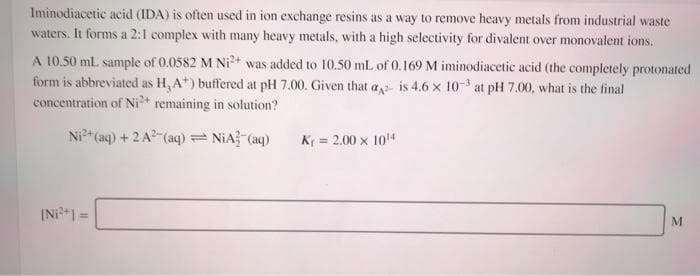Iminodiacetic acid (IDA) is often used in ion exchange resins as a way to remove heavy metals from industrial waste waters. It forms a 2:1 complex with many heavy metals, with a high selectivity for divalent over monovalent ions. A 10.50 ml. sample of 0.0582 M Ni2+ was added to 10.50 mL of 0.169 M iminodiacetic acid (the completely protonated form is abbreviated as H, A*) buffered at pH 7.00. Given that a is 4.6 x 10- at pH 7.00, what is the final concentration of Ni* remaining in solution? Ni (aq) + 2 A?-(aq) = NiA? (aq) K = 2.00 x 104
Iminodiacetic acid (IDA) is often used in ion exchange resins as a way to remove heavy metals from industrial waste waters. It forms a 2:1 complex with many heavy metals, with a high selectivity for divalent over monovalent ions. A 10.50 ml. sample of 0.0582 M Ni2+ was added to 10.50 mL of 0.169 M iminodiacetic acid (the completely protonated form is abbreviated as H, A*) buffered at pH 7.00. Given that a is 4.6 x 10- at pH 7.00, what is the final concentration of Ni* remaining in solution? Ni (aq) + 2 A?-(aq) = NiA? (aq) K = 2.00 x 104
Principles of Modern Chemistry
8th Edition
ISBN:9781305079113
Author:David W. Oxtoby, H. Pat Gillis, Laurie J. Butler
Publisher:David W. Oxtoby, H. Pat Gillis, Laurie J. Butler
Chapter11: Solutions
Section: Chapter Questions
Problem 26P
Related questions
Question

Transcribed Image Text:Iminodiacetic acid (IDA) is often used in ion exchange resins as a way to remove heavy metals from industrial waste
waters. It forms a 2:1 complex with many heavy metals, with a high selectivity for divalent over monovalent ions.
A 10.50 mL sample of 0.0582 M Ni2+ was added to 10.50 mL of 0.169 M iminodiacetic acid (the completely protonated
form is abbreviated as H, A*) buffered at pH 7.00. Given that a is 4.6 x 10-3 at pH 7.00, what is the final
concentration of Ni* remaining in solution?
Ni" (aq) + 2 A?-(aq)= NiA? (aq)
K = 2.00 x 104
IN1 =
Expert Solution
This question has been solved!
Explore an expertly crafted, step-by-step solution for a thorough understanding of key concepts.
This is a popular solution!
Trending now
This is a popular solution!
Step by step
Solved in 3 steps

Knowledge Booster
Learn more about
Need a deep-dive on the concept behind this application? Look no further. Learn more about this topic, chemistry and related others by exploring similar questions and additional content below.Recommended textbooks for you

Principles of Modern Chemistry
Chemistry
ISBN:
9781305079113
Author:
David W. Oxtoby, H. Pat Gillis, Laurie J. Butler
Publisher:
Cengage Learning

Chemistry
Chemistry
ISBN:
9781305957404
Author:
Steven S. Zumdahl, Susan A. Zumdahl, Donald J. DeCoste
Publisher:
Cengage Learning

Chemistry: An Atoms First Approach
Chemistry
ISBN:
9781305079243
Author:
Steven S. Zumdahl, Susan A. Zumdahl
Publisher:
Cengage Learning

Principles of Modern Chemistry
Chemistry
ISBN:
9781305079113
Author:
David W. Oxtoby, H. Pat Gillis, Laurie J. Butler
Publisher:
Cengage Learning

Chemistry
Chemistry
ISBN:
9781305957404
Author:
Steven S. Zumdahl, Susan A. Zumdahl, Donald J. DeCoste
Publisher:
Cengage Learning

Chemistry: An Atoms First Approach
Chemistry
ISBN:
9781305079243
Author:
Steven S. Zumdahl, Susan A. Zumdahl
Publisher:
Cengage Learning


Chemistry: Principles and Practice
Chemistry
ISBN:
9780534420123
Author:
Daniel L. Reger, Scott R. Goode, David W. Ball, Edward Mercer
Publisher:
Cengage Learning

Chemistry: Principles and Reactions
Chemistry
ISBN:
9781305079373
Author:
William L. Masterton, Cecile N. Hurley
Publisher:
Cengage Learning